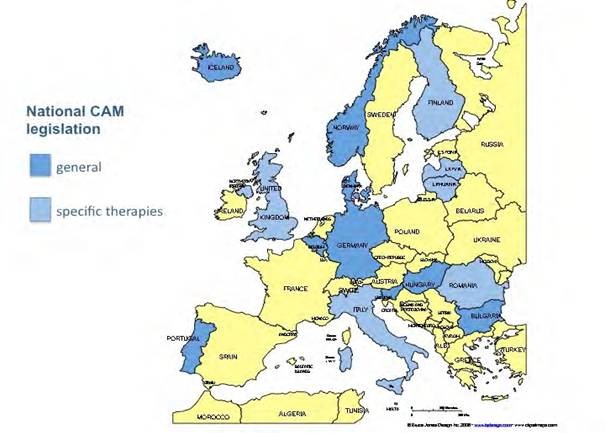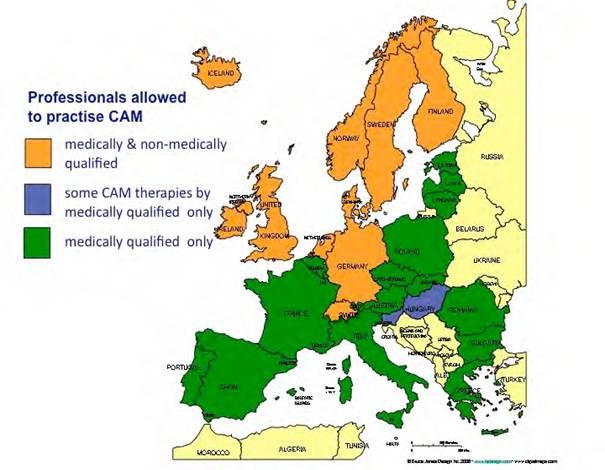Legal Status of CAM in Europe (Christian Dadomo)
Im Rahmen des 3. Europäischen Shiatsu-Kongress 2011 (13. bis 16. Oktober) präsentierte Christian Dadomo die rechtliche Situation von CAM in den EU-Mitgliedsländern (“Legal Status of CAM in EU Members”).
Christian Dadomo ist Senior Lecturer in European Union Law, Faculty of Business and Law, University of West of England, Bristol (UK)
What is Complementary and Alternative Medicine (CAM)?
- Complementary medicine is commonly used to refer to those methods which can be used alongside or to ‘complement’ conventional medicine
- Alternative medicine often refers to the use of therapies as substitutes for conventional medical treatment
- But the distinction between alternative and complementary medicine is not absolute and may depend on the context
- CAM conceived as “a group of diverse medical and health care systems, practices, and products that are not presently considered to be part of conventional medicine” (NCCAM[1]NCCAM: National Center for Complementary and Alternative Medicine; http://nccam.nih.gov)
The World Health Organization: “CAM refers to a broad set of health care practices that are not part of a country’s own tradition and not integrated into the dominant health care system”.
Institute of Medicine in the USA (2005): “….a broad domain of resources that encompasses health systems, modalities, and practices and their accompanying theories and beliefs, other than those intrinsic to the dominant health system of a particular society or culture in a given historical period.
CAM includes such resources perceived by their users as associated with positive health outcomes.
Boundaries within CAM and between the CAM domain and the domain of the dominant system are not always sharp or fixed”
Cochrane Complementary Medicine Field: “Complementary medicine includes all such practices and ideas which are outside the domain of conventional medicine in several countries and defined by its users as preventing or treating illness, or promoting health and well being. These practices complement mainstream medicine by:
- contributing to a common whole,
- satisfying a demand not met by conventional practices, and
- diversifying the conceptual framework of medicine.”
A diverse range of autonomous health-care practices used both for health support and prevention and for care in illness.
Taxonomy of CAM (NCCAM)
- Whole Medical Systems: medical systems of theory and practice
- Anthroposophic Medicine,
- Homeopathy,
- Naturopathic Medicine,
- Acupuncture,
- Culture specific systems (Traditional Chinese Medicine, Ayurveda, Unani)
- Mind-Body Medicine: minds capacity affects bodily functions
- Meditation, Imaging
- Biologically Based Practices: use of natural substances (e.g., herbs, vitamins)
- Phytotherapy,
- Aromatherapy
- Flower remedies
- Manipulative and Body-Based Practices
- Chiropractic,
- Osteopathy,
- Massage,
- Shiatsu
- Reflexology
- Energy Medicine
- Biofield Therapies: affect energy fields of the human body
- Bioelectromagnetic based therapies: use of electromagnetic fields
How Widespread is CAM in Europe?
- Use of CAM has grown and continues to grow at a significant rate across Europe year after year.
- CAM is becoming increasingly popular in Europe with up to 65% of the population reporting that they have used this form of medicine.
- Approximately 30-50% of the European population use CAM as self-support and 10-20% of the European population has seen a CAM physician/practitioner within the previous year.
- Large numbers of mainstream doctors are either referring to CAM practitioners or practising some of the more prominent and well-known forms of CAM
- In the European Union there are approximately 150,000 medical doctors who have taken training courses in a particular CAM therapy such as Acupuncture, Homeopathy, Anthroposophic Medicine or Natural Medicine, with figures for each therapy that are comparable to those of mainstream medical specialties.
- Most doctors practising CAM work in the ambulatory sector as GPs or medical specialists (any sort of specialty), in several European countries some of them work in mainstream hospitals including university teaching hospitals
(Quelle: CAMDOC Alliance[2]CAMDOC ALLIANCE: The European Committee for Homeopathy (ECH), the European Council of Doctors for Plurality in Medicine (ECPM), the International Council of Medical Acupuncture and Related Techniques … weiterlesen, 2010)
European Citizens´ Primary Motives for Choosing CAM
- Seeking a different philosophical view which perceives health in a holistic way and connects the physical, mental, emotional and spiritual aspects of their lives
- Dissatisfaction with biomedical treatment because of its ineffectiveness
- Worries about issues such as the adverse effects and toxicity of many conventional drugs and the growing resistance to antibiotics leading to a search for less-toxic alternatives
- Biomedical treatment is seen as impersonal and too technologically oriented
- to be given time and to be listened to, and alternative therapies are perceived as less authoritarian giving patients more personal autonomy, input and control over the decision-making regarding their care.
- They are also looking for a more intimate relationship with their health care providers. They want health professionals who respect them as partners in their care and who see and understand them as whole people with complex lives.
- CAM therapies are attractive because they are seen as more compatible with patients’ values, ethics, world-view, spiritual philosophy or beliefs regarding the nature and meaning of health and illness.
Who Provides CAM?
- Practitioners who have trained wholly in the CAM disciplines
- Conventional health care professionals – doctors, nurses, physiotherapists – who have done postgraduate training
How Is It Regulated?

- CAM regulation varies from country to country
- The variation is between the extremes of
- Certain therapies being legally restricted to doctors only (e.g. homeopathy in France, Austria)
- A common law situation where anyone can practise any „therapy“ (e.g. Netherlands, United Kingdom, Ireland)
Trends in Regulation

- Moves towards recognition and regulation: Belgium, Netherlands, Portugal (legislative moves to positively recognize and regulate Acupuncture, Homeopathy, Chiropractic, Osteopathy), United Kingdom (statutory regulation of the professions of Osteopathy and Chiropractic achieved with Acupuncture and Herbal Medicine soon to follow), Austria (recognition of Shiatsu as a profession), Slovenia (2007 Alternative Medicine Act)
- Moves towards restriction: Bulgaria, Italy (limit Homeopathy to doctors only)
Why Is the Regulation of CAM an Issue of Equity?
Significant limits to patient choice and access:
- Availability: lack of qualified or recognised practitioners
- Accessibility: restriction of practice to doctors only; restriction of products and medicines; lack of information about skills and education
- Quality: lack of minimum standards, ethical guidelines
- Financial: mostly private provision
Patients accessing the benefits of CAM in their home country cannot necessarily access them in other Member States.
What is the EU Position on CAM?
No official EU position on CAM particularly because healthcare services remain a national responsibility (Art 168 TFEU): “1. A high level of human health protection shall be ensured in the definition and implementation of all Union policies and activities.
Union action, which shall complement national policies, shall be directed towards improving public health, preventing physical and mental illness and diseases, and obviating sources of danger to physical and mental health. Such action shall cover the fight against the major health scourges, by promoting research into their causes, their transmission and their prevention, as well as health information and education, and monitoring, early warning of and combating serious cross-border threats to health.
The Union shall complement the Member States’ action in reducing drugs-related health damage, including information and prevention.”
Union action shall respect the responsibilities of the Member States for the definition of their health policy and for the organisation and delivery of health services and medical care. responsibilities of the Member States shall include the management of health services and medical care and the allocation of the resources assigned to them.
European Parliament Resolution (1997)
Called on the Commission to:
- Carry out studies into the safety, efficacy, & use
- Launch a process of recognising CAM
- Encourage the development of research programs
- Create a directive on food supplements
What Is the EU Position on CAM?
WHITE PAPER: Together for Health: A Strategic Approach for the EU 2008-2013 COM (2007) 630 final 23.10.2007: No specific references to CAM; “health policy must be based on the best scientific evidence derived from sound data and information, and relevant research.” (page 4)
- Products:
- Herbal and homeopathic medicines together with food supplements are regulated by EU Directives.
- Research:
- Seventh Framework Programme (FP7) Health theme: CAMbrella[3]CAMbrella: CAMbrella is a pan-European research network for complementary and alternative medicine (CAM); www.cambrella.eu kick-starts on 1 January 2010. (1.5 million euros)
- A pan-European research network for complementary and alternative medicine (CAM) designed to boost the well-being of European citizens by creating an EU-wide road map that encompasses the preconditions for future research within complementary and alternative medicine in Europe.
- The project’s specific objectives include:
- Development of consensus-based terminology widely accepted in Europe to describe CAM interventions,
- Creation of a knowledge base that facilitates our understanding of patient demand for CAM and its prevalence, and
- Exploration of the needs, beliefs and attitudes of EU citizens with respect to CAM.
- Free movement of services/establishment
- Freedom of choice of therapy
- But Medical System can still restrict practice of CAM to medical doctors or qualified practitioners
- Any restrictions to FMS[4]FMS: Family Medical Services and FE[5]FE: Further Education must be justified on the EU Treaty exceptions / issue of mutual recognition of qualifications
- EU citizens are free to move and therefore to receive treatment in another EU country
What Could the EU Do For CAM?
- Positively encourage national governments to legislate in a way which respects the diverse philosophical and theoretical bases of different CAM disciplines.
- Analyse the models of regulation that promote freedom of responsible practice, eg the Irish consultative model which seeks to both protect the rights of citizens to safe treatment and to support the right to practise of practitioners through regulation of training. Other excellent examples include recommendations and guidelines from the Council of Europe (1999) and WHO (2002).
- Promote the effective legal right of the professions to practise as access is entirely dependent on this.
What Can You Do?
- Citizens’ initiative
Article 11(4) TEU: “Not less than one million citizens who are nationals of a significant number of Member States may take the initiative of inviting the European Commission, within the framework of its powers, to submit any appropriate proposal on matters where citizens consider that a legal act of the Union is required for the purpose of implementing the Treaties.”
Quelle
Präsentation von Christian Dadomo am 3. Europäischen Shiatsu Kongress in Kiental 2011
Anmerkungen
| ↑1 | NCCAM: National Center for Complementary and Alternative Medicine; http://nccam.nih.gov |
|---|---|
| ↑2 | CAMDOC ALLIANCE: The European Committee for Homeopathy (ECH), the European Council of Doctors for Plurality in Medicine (ECPM), the International Council of Medical Acupuncture and Related Techniques (ICMART) and the International Federation of Anthroposophic Medical Associations (IVAA), constitiute the CAMDOC Alliance representing 132 European associations of medical doctors practising Complementary Medicine (also called Complementary and Alternative Medicine – CAM); http://www.camdoc.eu |
| ↑3 | CAMbrella: CAMbrella is a pan-European research network for complementary and alternative medicine (CAM); www.cambrella.eu |
| ↑4 | FMS: Family Medical Services |
| ↑5 | FE: Further Education |